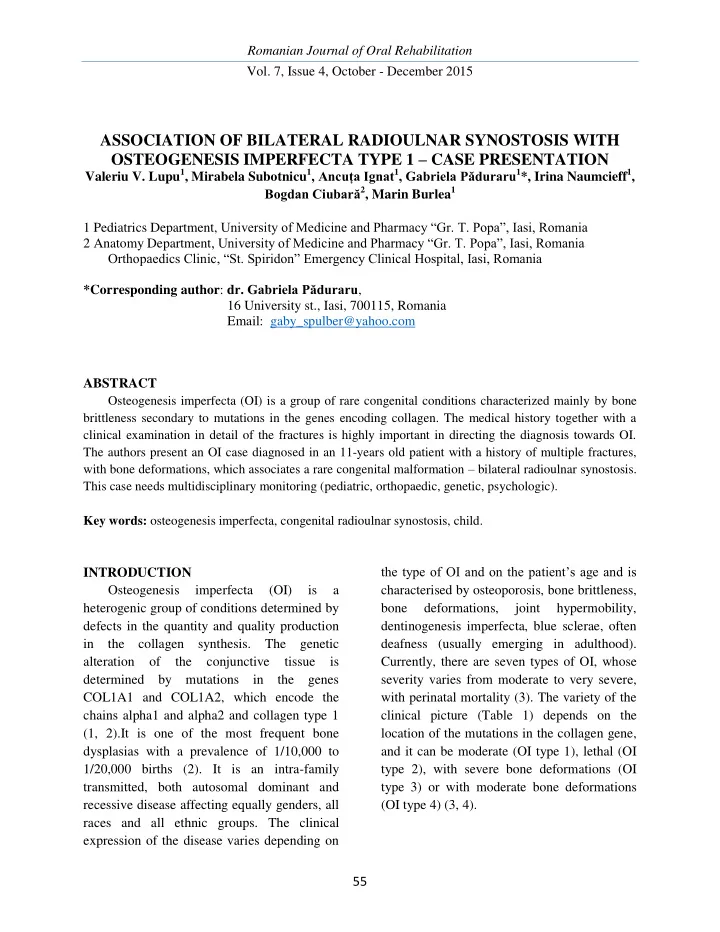

Romanian Journal of Oral Rehabilitation Vol. 7, Issue 4, October - December 2015 ASSOCIATION OF BILATERAL RADIOULNAR SYNOSTOSIS WITH OSTEOGENESIS IMPERFECTA TYPE 1 – CASE PRESENTATION Valeriu V. Lupu 1 , Mirabela Subotnicu 1 , Ancuța Ignat 1 , Gabriela Păduraru 1 *, Irina Naumcieff 1 , Bogdan Ciubară 2 , Marin Burlea 1 1 Pediatrics Department, University of Medicine and Pharmacy ―Gr. T. Popa‖, Iasi, Romania 2 Anatomy Department , University of Medicine and Pharmacy ―Gr. T. Popa‖, Iasi, Romania Orthopaedics Clinic, ―St. Spiridon‖ Emergency Clinical Hospital, Iasi, Romania *Corresponding author : d r. Gabriela Păduraru , 16 University st., Iasi, 700115, Romania Email: gaby_spulber@yahoo.com ABSTRACT Osteogenesis imperfecta (OI) is a group of rare congenital conditions characterized mainly by bone brittleness secondary to mutations in the genes encoding collagen. The medical history together with a clinical examination in detail of the fractures is highly important in directing the diagnosis towards OI. The authors present an OI case diagnosed in an 11-years old patient with a history of multiple fractures, with bone deformations, which associates a rare congenital malformation – bilateral radioulnar synostosis. This case needs multidisciplinary monitoring (pediatric, orthopaedic, genetic, psychologic). Key words: osteogenesis imperfecta, congenital radioulnar synostosis, child. the type of OI and on the patient’s age and is INTRODUCTION Osteogenesis imperfecta (OI) is a characterised by osteoporosis, bone brittleness, heterogenic group of conditions determined by bone deformations, joint hypermobility, defects in the quantity and quality production dentinogenesis imperfecta, blue sclerae, often in the collagen synthesis. The genetic deafness (usually emerging in adulthood). alteration of the conjunctive tissue is Currently, there are seven types of OI, whose determined by mutations in the genes severity varies from moderate to very severe, COL1A1 and COL1A2, which encode the with perinatal mortality (3). The variety of the chains alpha1 and alpha2 and collagen type 1 clinical picture (Table 1) depends on the (1, 2).It is one of the most frequent bone location of the mutations in the collagen gene, dysplasias with a prevalence of 1/10,000 to and it can be moderate (OI type 1), lethal (OI 1/20,000 births (2). It is an intra-family type 2), with severe bone deformations (OI transmitted, both autosomal dominant and type 3) or with moderate bone deformations recessive disease affecting equally genders, all (OI type 4) (3, 4). races and all ethnic groups. The clinical expression of the disease varies depending on 55
Romanian Journal of Oral Rehabilitation Vol. 7, Issue 4, October - December 2015 Type Severity Characteristics I Mild Normal height, lack of bone deformations or mild deformations, vertebral fractures, blue sclerae, normal walk II Perinatal mortality Multiple fractures III Severe Small height, scoliosis, triangular face, grey sclerae, difficult supported walk IV Moderate Small height, scoliosis, triangular face, white sclerae, difficult supported walk V Moderate Medium height, abnormal callus, ossification of the interosseous membrane of the forearm and lower limbs, radioulnar synostosis, white sclerae Moderate – severe VI Medium height, frequent fractures, while sclerae Moderate Small height, coxa vara, anomalies of the humerus and VII femur, white sclerae Table 1. Classification of the types of osteogenesis imperfect CLINICAL CASE fracture; 4 years old, bilateral congenital proximal radioulnar synostosis – operated. A female patient, 11 years and 3 months old, is admitted in the pediatric ward for the Psychological evaluation at the age of 6 years: supplementation of investigations in view of mild mental retardation (IQ = 40), identifying the etiology of her osteomuscular polymorphic dyslalia. Menarche at the age of disorder. 10 years and 8 months with significant Family history: parents and siblings dysfunctions of the menstrual cycle. apparently healthy, without consanguinity The objective examination upon relations, mother 5 pregnancies, 3 births (2 admission revealed a good general status, abortions on request). Obstetrical history: the facial dimorphism, normally coloured second child coming from a non-monitored teguments, blue sclerae, pectus excavatum, pregnancy with physiological evolution, dextroscoliosis, angulation persistence in the natural birth at 39 weeks of pregnancy, with elbow joint making full extension impossible, BW=2900g, H=54cm, APGAR – 8, no fetal bilateral deformation of the 5 th finger in distress during birth. bilateral flexion. There were no auscultation In the patient’s history, the following changes in the cardiovascular and respiratory events stood out: 8 months old, left 1/3 systems. Osteotendinous reflexes were present medium lower tibia spiroid fracture; 1 year bilaterally, and muscular strength was and 4 months old, left distal tibial metaphyseal moderately diminished. 56
Romanian Journal of Oral Rehabilitation Vol. 7, Issue 4, October - December 2015 Laboratory tests: full blood count Imaging explorations Abdominal and thyroid ultrasonography – WBC=7,100/mm 3 , Hb=12.9g/dl, PLT=265,000/mm 3 , liver and kidneys within within normal limits; radiologically, long bones: humerus, femur and leg bilaterally – normal limits, euglycemic, phosphor-calcic within normal limits; in the forearm – bilateral metabolism and thyroid hormones within normal limits. proximal radioulnar synostosis, with the forearm bones roughly modelled, with diaphyseal cortical thickening and the lack of joint space in the left elbow (Fig. 1). Fig 1. Bilateral forearm radioulnar synostosis Spine X-ray: upper back dextroscoliosis, differentiation between the white and the grey lower back levoscoliosis, and lumbar matter. levoscoliosis with the apex in L2-L3. The genetic consultation revealed weight, height and cranial perimeter within normal Vertebral body D12 with increased limits, with cranial-facial dimorphism, anteroposterior diameter in comparison to the (antimongoloid palpebral fissures, blue rest of the vertebral bodies. sclerae, nasal voice, low position of the ears), The cranial CT scan did not highlight any pectus excavatum, bilateral radioulnar changes in the scanned bone structures, the 5 th synostosis operated, bilateral finger brain matter showing densities within normal camptodactyly (Fig. 2), fingers with thinned limits, circumvolutions present and visible distal phalange, moderate psychomotor retardation, language impairment, irregular menstrual cycles. Fig.2 5 th finger camptodactyly 57
Recommend
More recommend